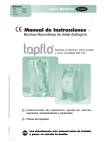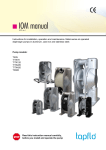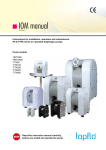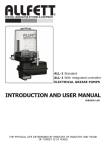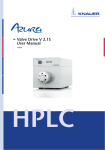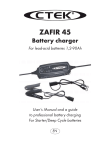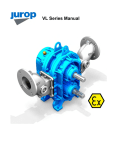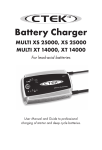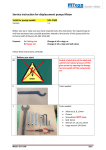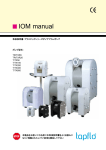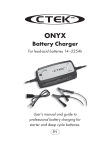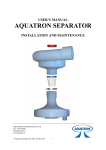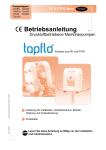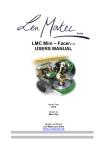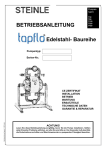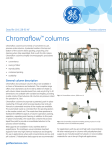Download instruction metal series english - firma-web
Transcript
Pump models TR9 T100 TR20 T200 T50 T400 PE & PTFE series English Instruction manual Air operated diaphragm pumps Edition 3/2004 C:\arbetsfiler\instruktioner\tapflo\pumpar\pe & ptfe eng\instruction peptfe series english.pmd Pumps in polyethylene or PTFE Instructions for installation, start up, operation, maintenance and repair Spare parts STOP Read this instruction manual carefully, before you install and operate the pump CONTENTS CE CERTIFICATE 3 0 GENERAL 4 0.1 0.2 Introduction The waring symbols 4 4 1 INSTALLATION 5 1.1 1.2 1.3 1.4 1.4.1 1.4.2 1.4.3 1.5 1.5.1 1.6 1.7 1.7.1 1.7.2 1.7.3 Receiving inspection Storage Foundation Suction and discharge pipings Turnable connections Connection of suction pipe Connection of discharge pipe Air connection Air treatment system Example of installation Recommended installations Flooded Selfpriming Submerged 5 5 5 5 5 5 5 5 6 6 7 7 7 7 2 OPERATION 8 2.1 2.1.1 2.1.2 2.1.3 2.1.4 2.1.5 2.2 2.3 2.3.1 2.3.2 2.4 Health and safety Protection Environments in danger of explosion Air pressure Noise level Temperature hazards Before starting the pump Starting and operating Dry running Optimizing the pump lifetime Pump stopping 8 8 8 8 8 8 8 9 9 9 9 3 MAINTENANCE 3.1 3.1.1 3.2 3.3 3.4 3.5 3.5.1 3.5.2 When the pump is new or reassembled Performance test Routine inspection Complete inspection Location of faults Dismantling the pump Before the dismantling procedure Mainparts Instruction manual PE & PTFE series pumps 10 10 10 10 10 10 11 11 11 2 3.5.3 3.5.4 3.6 3.6.1 3.6.2 3.6.3 3.6.4 Housing Center block Assembly of the pump Center block Suction and discharge connections Assembling of the main units Test run 4 SPARE PARTS 4.1 4.2 4.3 4.4 4.5 4.6 Spare parts TR9 and TR20 Spare parts T50 and T100 Spare parts T200 and T400 Stocking recommendation How to order parts Pump code 5 DATA 5.1 5.2 5.3 5.4 5.5 Capacity curves Capacity changes Dimensions Technical data Tightening torques 6 WARRANTY & REPAIR 6.1 6.2 6.3 Returning parts Warranty Warranty form 11 11 12 12 12 12 12 13 13 14 15 16 16 16 17 17 17 18 19 19 20 20 20 21 CE CERTIFICATE Declaration of conformity Machinery directive 98/37/EC, Annex 2A Tapflo AB declares that: Product name: Models: Air operated diaphragm pumps T… Is in conformity with the essential health and safety requirements and technical construction file requirements of the EC Machinery directive 98/37/EC with amendments. Manufacturer: Tapflo AB Address: Filaregatan 4 S-442 34 Kungälv Sweden Tapflo AB, september 1st 1999 Börje Johansson Managing director Instruction manual PE & PTFE series pumps 3 0. GENERAL 0.1 Introduction The Tapflo Air Operated Diaphragm Pump range is a complete serie of pumps for industrial applications. The pumps are designed to be safe simple and easy to use and maintain. The construction is sealless and without rotating parts. The pumps are suitable for almost all different chemicals used by the industry today.. With proper attention to maintenace, Tapflo Pumps will give efficient and trouble free operation. This instruction manual will familiarise operators with detailed information about installing, operating and maintaining the pump. 0.2 The warning symbols The following warning symbols are present in this instruction manual. This is what they say. STOP ! This symbol stands next to all safety instructions in this instruction manual where danger to life and limb may occur. Observe these instructions and proceed with utmost caution in these situations. Inform also other users of all safety instructions. In addition to the instructions in this instruction manual, the general safety and accident prevention regulations must be observed. This signal stands at points in this instruction manual of particular importance for compliance with regulations and directives, for correct work flow and for the prevention of damage to and destruction of the complete pump or its subassemblies. Instruction manual PE & PTFE series pumps 4 1. INSTALLATION 1.1 Receiving inspection Although precaution is taken by us when packing and shipping, we urge you to carefully check the shipment on receipt. Make sure that all parts and accesories listed on the packing list are accounted for. Immediately report any damage or shortage to the transport company and to us. 1.2 ! 1.3 ! 1.4 Storage If the equipment is to be stored prior to installation, place it in a clean location. Do not remove the protective covers from the suction, discharge and air connections which have been fastened to keep pump internals free of debris. Clean the pump thoroughly before installation. Foundation The pump is furnished with vibration absorbing rubber feet. The pump will operate properly without being fixed to a foundation. If fixation is needed for an installation, make sure the foundation is able to absorb vibrations. It is essential for the operation of the pump to mount the pump with the feet in a downward direction (see sketch). Suction and discharge pipings Suction and discharge piping should be fully supported and anchored near to but independent of the pump. The piping to the pump should be a hose, to prevent undue stress and strain on the pump connections and the pipings. 1.4.1 Turnable connections The suction and discharge connections are turnable 180°. This simplifies the assembling and installation considerably. If you wish to turn the connections, screw a threaded nipple into the connection and turn. On the larger models T200 and T400 it will simplify if the housing nuts are slightly released while turning the connections. 1.4.2 Connection of suction pipe Remember that the suction pipe/connection is the most critical point, especially if the pump is priming. Just a small leakage will dramatically reduce the suction capability of the pump. When connecting the suction pipe, following is recommended. 1) For satisfactory operation, use reinforced hose or corresponding (the suction power may otherwise shrink the hose). The internal diameter of the hose should be the same as on the suction connection (at the bottom of the pump) to have best suction capability. 2) Make sure that the connection hose - pump is completely tight, otherwise the suction capability will be reduced. 3) Always use as short suction pipe as possible. Avoid air pockets which can arise with long pipings. 1.4.3 STOP Connection of discharge pipe For this connection it is only recommended a simple and positive flow connection. Use a hose or flexible piping (minimum one meter) between the discharge connection and any rigid fixed piping. Coil the hose at least one turn. All components (hose, pipe, valves etc) on the discharge piping must be designed for minimum PN 10. 1.5 Air connection Screw the air hose into the air intake on the center block of the pump with for example a bayonet coupling. For best efficiency, use the same hose diameter as the internal diameter of the connection on the air intake. Instruction manual PE & PTFE series pumps 5 1. INSTALLATION 1.5.1 ! Air treatment system The air valve is constructed for oilfree air. Lubrication of the air is not allowed. However, if the air is very dry (laboratory air), the air may be lubricated with water. Maximum air pressure is 8 bar. As prevention purpose, a filtration of the air by means of a 5 micron filter or finer is recommended. Dirt in the air can under unfortunate circumstances be the cause of breakdown. To facilitate the operation of the pump we recommend an air treatment system connected to the air supply. These components should be included: 1) 2) 3) 4) Regulator to adjust the air pressure Manometer to read the actual pressure Needle valve to adjust the air flow Filter These components are included in Tapflos Air treatment system which can be ordered from us. 1.6 Example of installation 1) 2) 3) 4) 5) 6) 7) 8) 9) Gate valve compressed air Filter and pressure regulator Flexible hose Needle valve Flexible piping Gate valve suction Gate valve discharge Coiled flexible piping Flow gauge Instruction manual PE & PTFE series pumps 6 1. INSTALLATION 1.7 Recommended installations The Tapflo pump is flexible in the way you are able to install it. The in- and outlet ports are infinitely turnable more than 180° to fit various piping systems. 1.7.1 ! Flooded The piping system is designed with a positive suction head. This is the best way of installtion where it is necessary to completely evacuate all liquid from the container, or where viscous (thick) products are transfered. Important Do not exceed 0,7 bar suction pressure. Higher pressure may cause premature diaphragm failure and irregular pump operation. 1.7.2 Selfpriming The Tapflo pump is designed to pull a high vacuum. It is able to evacuate an empty suction pipe without any damage to the pump. The suction lift is up to 5 meter (16.4 ’) from an empty suction pipe and up to 8 meter (26.2’) from a wetted pipe. The suction capability depends on the pump size (see chapter 5.4) 1.7.3 Submerged All Tapflo pumps may be submerged into the liquid. It is important to make sure that all components which are in contact with the liquid are chemically compatible. The air exhaust must be led to the athmosphere by means of a hose. Air exhaust port dimension Pump size Air exhaust port TR9, TR20 and T50 T100, T200 and T400 1/2" BSP 1" BSP Instruction manual PE & PTFE series pumps 7 2. OPERATION 2.1 Health and safety The pump must be installed according to local and national safety rules. STOP 2.1.1 STOP 2.1.2 STOP The pumps are constructed for particular applications. Do not use the pump on applications different from that for which it was sold without consulting us to ascertain its suitability. Protection In the interest of health and safety it is essential to wear protective clothing and safety goggles when operating, and/or working in the vicinity of Tapflo pumps. Environments in danger of explosion The standard PE or PTFE series pumps are not allowed to operate in environments in danger of explosion. Static electricity may occur in the pump under operation, which may cause explosion and injury. Special conductive pumps TX are available for such applications. If you have purchased a TX pump, also carefully read the ATEX instruction appendix. Consult us for further information. Follow the explosion safety rules applicable at the location for the pump. 2.1.3 Air pressure The maximum air pressure for Tapflo pumps is 8 bar. Higher air pressure than 8 bar can damage the pump and may cause injury to personel in vicinity of the pump. If you intend to apply a higher air pressure than 8 bar, please consult us. 2.1.4 Noise level At tests, the noise level from a Tapflo pump has not exceeded 80 dB(A). Under some circumstances, for example if the pump is operating under high air pressure at low discharge head, the noise can be inconvenient or hazardous for personel staying for long periods in vicinity of the pump. This hazard can be prevented by: STOP - using suitable ear protection - lower the air pressure and/or raise the discharge head - lead the outcomming air from the place by connecting a hose from the muffler connection of the pump. You will find the air exhaust dimension in chapter 1.7.3. - use elastomer valve balls (EPDM, NBR or polyurethane) instead of PTFE, ceramic or stainless steel, provided that the elastomer is compatible with the pumped liquid. 2.1.5 Temperature hazards Raised temperature can cause damage on the pump and/or pipings and may also be hazardous for personel in the vicinity of the pump/pipings. Avoid quick temperature changes and do not exceed the maximum temperature specified when the pump was ordered. See also general max temperatures based on water in chapter 5 "Data". 2.2 Before starting the pump - Make sure the pump is installed accordning to the installation instruction (section 1). - Filling of the pump with liquid before start is not necessary. - When installation is new or reinstalled, a test run of the pump with water should be conducted to make sure the pump operates normally and does not leak. STOP Instruction manual PE & PTFE series pumps 8 2. OPERATION 2.3 Starting and operating - Open the discharge valve. - Note! Considering the suction capacity when air is still in the suction pipe, it is recommended to start with low air pressure/flow in the beginning. This is not necessary if the pump is filled with liquid before start. - When the pump has been filled with liquid, the air pressure/flow may be raised to increase the suction capacity of the pump. - The performance of the pump can be adjusted through the air supply by using a needle valve and a pressure regulator. The performance can also be adjusted by normal flow control on the discharge side of the system. 2.3.1 Dry running The pump may run dry without any problem. 2.3.2 Optimizing the pump lifetime Running at full frequenzy (maximum air pressure/flow) continiously will cause premature wear of the components. As a general rule, we recommend to run at half of the maximum capacity of the pump. For instance, a T100 pump should run continious maximum at 50 l/min. 2.4 Pump stopping The pump can be stopped in two ways: 1) Close the discharge valve. The pressure from the system will stop the pump automatically. This will not do any damage to the pump. The pump restarts easy when the valve is opened again. 2) Stop the air supply. Instruction manual PE & PTFE series pumps 9 3. MAINTENANCE 3.1 ! 3.1.1 3.2 ! 3.3 ! When the pump is new or reassembled If the pump is new or reassembled after maintenance it is important to retighten the pump housing nuts (pos 37) after a few days of operation. Make sure to use the right torque, see chapter 5.5. Performance test When installation is new, a test run of the pump should be conducted. Gauge the capacity at specific air pressure/flow. This information is for use in checking performance as wear takes place. You will be able to set schedules for maintenance of the pump and to select spare parts to be kept on stock. Routine inspection Frequent observation of the pump operation is recommended to detect problems. A change in sound of the running pump can be an indication of weared parts (see below "location of faults"). Leaking liquid from the pump and changes of performance may also be detected. Routine inspections should be conducted frequently. Complete inspection The intervals for a complete inspection depend upon the operation conditions for the pump. The characteristics of the liquid, temperature, materials used in the pump and running time decide how often a complete inspection is necessary. If a problem has occured, or if the pump is in need of a complete inspection, see later this chapter "location of faults" and "dismantling of the pump". You are of course warmly welcome to consult us for further help. Worn parts should be carried in stock, see our recommendation in chapter 4.4. 3.4 Location of faults Problem Possible fault The pump does not run The air pressure is to low The air connection is blocked Muffler is blocked Air valve is defect Dirt in the pump chamber Diaphragm breakdown The suction is bad Suction connection is not tight Suction connection is blocked Muffler is blocked Valve balls are blocked Valve balls are damaged The pump runs irregularly Valve balls are blocked Sealings are defect in air valve or center block Diaphragm breakdown Bad flow/pressure Pressurefall in incomming air Suction or air connection blocked Muffler is blocked Air valve is defect Valve balls worn out/broken Air in liquid Diaphragm breakdown Liquid leaks from the pump Screws on the housing not properly fastened Liquid comes out of the muffler Diaphragm breakdown Instruction manual PE & PTFE series pumps 10 3. MAINTENANCE 3.5 Dismantling the pump The numbers put in brackets, refer to the part numbers in the spare part drawings and spare part lists in chapter 4. 3.5.1 STOP Before the dismantling procedure Be sure to drain all liquid from the pump. Cleanse or neutralize the pump thoroughly. Disconnect the air connection and then the suction and discharge connections. 3.5.2 Mainparts 1) Unscrew the nuts (37) on one side of the housing (11). 2) Place the pump on the side that still has the nuts (the pump lays on the nuts) on a stable ground, for example a table. 3) Carefully remove the "loose housing" (11). 4) Carefully lift up the suction and discharge connections (13). You have the center block (12) and one of the housings with pin screws (14) left. 5) Upend the pump and carefully pull out the pin screws (14). Be careful with the diaphragms (15) that easily can be damaged by the threads of the pin screws. The mainparts of the pump are now dismantled. The following is for dismantling the housing and center block in detail. 3.5.3 Housing 1) Put the house wall with the flat side down on a plane surface that will not damage the housing, for example a table covered with cardboard. 2) Remove the spacer sleeve (19), by turning it 180°. To do that, put a piece of plastic towards one side of the spacer sleeve - knock on it so that the spacer sleeve is turning. Then put one of the pin screws in the hole on the spacer sleeve and turn it as far as it is possible, until it lays upside down (180°) compared to the starting position. Pull the spacer sleeve carefully against the lower valve seat (21) until it is free and can be put out. Please note that force never shall be used for dismantling. 3) Stick something not pointed (for example a pin screw with one of the nuts on) into the hole for the discharge connection and press gently out the upper valve seat (20). 4) Place one of the pin screws on the inside (behind) the valve ball stopper on the lower valve seat (21). Carefully pull out the valve seat in the housing. 5) In order to remove the valve ball (23) from the valve seat, use a pin screw and press carefully out the valve ball stopper (22) and the valve ball will be free. 3.5.3.1 For TR9 and TR20 Dismantling of the spacer sleeve: Screw a pin screw into the spacer sleeve, pull it up and then out from the housing. 3.5.4 Center block 1) Press the diaphragms (15) to their neutral position (both have the same distance to the center block). 2) Hold one of the diaphragms (15) and unscrew the other. Then pull out the remaining diaphragm with the diaphragm shaft (16). Instruction manual PE & PTFE series pumps 11 3. MAINTENANCE 3) Dismantle the circlips (27) which keep the air valve (61) on it's place, press out the air valve with for instance a wood shaft of a hammer or by means of a pressing device. Always be careful, so that you do not damage the sealing edges towards the diaphragm or the air valve. 4) If the shaft sealings (36) seem to be worn out (by internal leakage of air), carefully remove them with a pointed tool. During this operation, the sealing (36) and backup o-ring (47) usually get destroyed, so make sure to have replacement spares available. The pump is now completely dismantled. Check all components for wear or damage and replace if necessary. 3.6 Assembly of the pump 3.6.1 Center block 1) Mount the circlip (27) on one side. Put some soft soap solution on the air valve o-rings (30) and then carefully push the air valve (61) into the housing. On the bigger pumps, it is necessary to use a pressing device for this operation. Make sure that the o-rings (30) remain in the right position. Put the circlip (27) on the other side. 2) Put the diaphragm (15) with shaft (16) into the center block. Screw the next diaphragm (15) onto the shaft (16) and fix the holes. Sometimes you have to turn the diaphragms a little back to get the holes fixed. 3.6.2 Suction/discharge connections Always make sure that the o-rings (18) are placed on the in/outlet (13) before all assembling of pump. Special for pump with PTFE diaphragms: U-rings (18) are placed on the pump housing. Put u-ring with open side up so you carefully can put the o-ring in the groove. Make sure you do not fold the inner edge of the u-ring. 3.6.3 Assembling of the main units 1) Turn the housing (11) with the flat side up. 2) Make sure all pin screws (14) have one nut (37) and one washer (38) each. Nut should only be put on one or two threads. 3) Put all the pin screws through the housing and then turn the housing so it rests on the nuts. 4) Let the center block (12) gently be put to the housing with screws through center block. Be careful that threads on screws do not damage the diaphragms when assembling. 5) Place suction and discharge connections (13) in their positions in the housing. Be careful not to damage the u-ring (PTFE model) and o-rings (18). 6) Put the second housing (11) onto the pin screws (14). Make sure that suction/discharge connections are in right direction and again be careful with the u-ring/o-rings. 7) Fasten the nuts (37) alternatingly by hand, with or without washers depending on how much of the thread comes out. When all nuts are fastened, turn them gently with a tool so that the pump gets closed. If some of the nuts were fastened without washer, unscrew thoose and put washers underneath. See recommended tightening torques in chapter 5. After a few weeks operation a follow up draft of the nuts is recommended. 3.6.4 Test run We recommend you to conduct a test run of the pump before installing it to the system so no liquid gets wasted if the pump leaks or perhaps does not start according to wrong assembling of the pump. Instruction manual PE & PTFE series pumps 12 4. SPARE PARTS 4.1 Spare parts TR9 and TR20 Pos Description 11 12 13 14 15 17 18 19 20 21 22 Housing Center block In/Outlet Pin screw Diaphragm Rubber foot O-ring set (in/outlet) Spacer sleeve Lower rod Upper rod Pin Qty/pump Instruction manual PE & PTFE series pumps 2 1 2 4 2 4 4 2 2 2 2 13 Pos Description 25 27 30 33 37 38 57 61 63 64 65 Muffler Circlip O-ring Plug Nut Washer Nut cover Air valve complete Drum inlet Pump tube Handle Qty/pump 1 2 6 2 8 8 8 1 1 1 1 4. SPARE PARTS 4.2 Spare parts T50 and T100 Pos Description 11 12 13 14 15 16 17 18 19 20 21 22 23 25 Housing Center block In/Outlet Pin screw Diaphragm Diaphragm shaft Rubber foot O-ring set (in/outlet) Spacer sleeve Upper valve seat Lower valve seat Valve ball stop Valve ball Muffler Qty 2 1 2 6 2 1 4 4 2 2 2 4 4 1 Pos Description 26 27 30 33 36 37 38 43 47 57 61 63 64 65 Air intake adapter Circlip O-ring Plug Center block sealing Nut Washer O-ring (valve seat) O-ring (back up for 36) Nut cover Air valve complete Drum inlet Pump tube Handle * = on T50, ** = on T100 Instruction manual PE & PTFE series pumps 14 Qty 1 2 6 2 2 12 12 4 2*/4** 12 1 1 1 1 4. SPARE PARTS 4.3 Spare parts T200 and T400 Pos Description 11 12 13 14 15 16 17 18 19 20 21 22 23 Housing Center block In/Outlet Pin screw Diaphragm Diaphragm shaft Rubber foot O-ring set (in/outlet) Spacer sleeve Upper valve seat Lower valve seat Valve ball stop Valve ball Instruction manual PE & PTFE series pumps Qty 2 1 2 8 2 1 4 4 2 2 2 4 4 15 Pos Description Qty 25 26 27 30 33 36 37 38 43 47 57 61 Muffler Air intake adapter Circlip O-ring Plug Center block sealing Nut Washer O-ring (valve seat) O-ring (back up for 36) Nut cover Air valve complete 1 1 2 6 2 2 16 16 4 2 16 1 4. SPARE PARTS 4.4 Stocking recommendation Even at normal operation some details in the pump will be subject to wear. In order to avoid expensive breakdowns we recommend having a few spare parts in stock. Depending on the severity of the operation and the importance of not having a breakdown we offer two different spare part sets. Set No 2 Set No 1 Qty 2 4* 2+2** 1 4 Description Diaphragm Valve ball Rod valve Muffler O-ringset Pos Qty 15 23 20, 21 25 18 1 1* 2* 2* 2 2**/4* 2 2* 4* 2*/4*** 1 * = Only T50 up to T400 ** = Only TR9 and TR20 *** = Only T100 4.5 Description Pos Spare part set No 1 Diaphragm shaft Upper valve seat Lower valve seat Spacer sleeve Pin Circlip Center block seal O-ring valve seat O-ring Air valve complete 16 20 21 19 22 27 36 43 47 61 How to order parts When ordering spare parts for Tapflo Pumps, please let us know the model number from the nameplate of the pump. Then just indicate the part numbers (refered to the spare part list) and quantity of each item. 4.6 Pump code The model number on the pump tells the pump size and material of the pump components. Tapflo diaphragm pump Max capacity (l/min) T RD Special execution: A = Aluminium centerblock B = Backup diaphragm system D = Drum pump E = Valve seat insert (PU, PTFE or AISI 316) F = Filterpress pump G = Cast iron centerblock H = Pump with housing reinforcement plates K = Short shaft version L = Draining system M = Optional connection type N = FEP o-rings (pos 18) Q = Special sealed pump R = Rod valves S = AISI 316/FKM air valve T = Twin pump V = AISI 316L valve seat / spacer X = ATEX approved, group II, cat 2 Z = Semiconductor industry pump Instruction manual PE & PTFE series pumps 20 Material of wetted thermoplastic parts: P = PE (polyethylene) T = PTFE P T Material of diaphragms: E = EPDM N = NBR (nitrile rubber) T = PTFE V = FKM (TR9 only) 16 P Material of valve balls: E = EPDM N = NBR (nitrile rubber) T = PTFE S = AISI 316 stainless steel P = PU (polyurethane) K = Ceramic Material of rod valves (TR9 and TR20 only) P = PE (polyethylene) T = PTFE 5. DATA 5.1 Capacity curves The performance curves are based on water at 20°C.Other circumstances might change the performance.See below how the capacity will change at different viscosities and suction lifts. Example (see the orange coloured line): A flow of 6 liter/minute is desired. The discharge pressure is calculated to 4 bar. We choose a TR9. It requires an air pressure of 6 bar and will consume approximately 0.085 m3 air per minute. 5.2 TR9 TR20 T50 T100 T200 T400 Capacity changes Capacity changes at different viscosities Capacity changes at different suction lifts Instruction manual PE & PTFE series pumps 17 5. DATA 5.3 Dimensions Standard pumps T Dimensions in mm (where other is not indicated) Dimensions in inch (where other is not indicated) Dim A A2 B B2 B3 C D D2 D3 D4 E E2 E3 F F2 G H H2 I J J2 K L M N P R S ØT U V Pump size 9 20 50 100 200 400 70 105 150 200 270 350 2.76 4.13 5.91 7.87 10.63 13.78 150 300 300 404 5.91 11.81 11.81 15.91 94 112 160 214 310 380 3.70 4.41 6.30 8.43 12.20 14.96 168 221 320 390 6.61 8.70 12.60 15.35 277 391 490 598 10.91 15.39 19.29 23.54 115 135 190 250 345 425 4.53 5.31 7.48 9.84 13.58 16.73 123 168 243 320 450 563 4.84 6.61 9.57 12.60 17.72 22.17 175 250 325 6.89 9.84 12.80 385 550 700 770 15.16 21.65 27.56 30.31 343 477 630 690 13.50 18.78 24.80 27.17 92 132 190 252 345 440 3.62 5.20 7.48 9.92 13.58 17.32 147 210 280 5.79 8.27 11.02 250 333 467 588 9.84 13.11 18.39 23.15 8 8 15 15 30 30 0.31 0.31 0.59 0.59 1.18 1.18 15 21 21 0.59 0.83 0.83 9 15 17 30 30 30 0.35 0.59 0.67 1.18 1.18 1.18 10 15 16 30 30 30 0.39 0.59 0.63 1.18 1.18 1.18 19 33 35 35 0.75 1.30 1.38 1.38 12 15 20 28 38 48 0.47 0.59 0.79 1.10 1.50 1.89 1/4” 3/8” 1/2” 1” 1 1/2” 2” 1/4 3/8 1/2 1 1 1/2 2 1/4” 3/8” 1/2” 3/4” 1” 1 1/2” 1/4 3/8 1/2 3/4 1 1 1/2 M4x20 M4x20 M8x25 M8x25 M8x25 M8x25 M4 M4 M8 M8 M8 M8 1/8” 1/8” 1/4” 1/4” 1/2” 1/2” 1/8 1/8 1/4 1/4 1/2 1/2 15 17 25 38 54 70 0.59 0.67 0.98 1.50 2.13 2.76 58 81 115 154 211 268 2.28 3.19 4.53 6.06 8.31 10.55 35 52 80 105 143 183 1.38 2.05 3.15 4.13 5.63 7.20 0° 0° 15° 15° 0° 0° 0° 0° 15° 15° 0° 0° 13 15 21 27 35 42 0.51 0.59 0.83 1.06 1.38 1.65 20 33 33 0.79 1.30 1.30 1270* 1270* 1270* 50.0* 50.0* 50.0* 285 360 400 11.22 14.17 15.75 * = Any length up to 2000 mm upon request * = Any length up to 79” upon request Instruction manual PE & PTFE series pumps 18 Drum pumps TD Twin pumps TT Filterpress pumps TF 5. DATA 5.4 Technical data Data Pump size 50 100 9 20 General characteristics *Max capacity (l/min) / (US gpm) **Volume per stroke (ml) / (cu in) Max discharge pressure (bar) / (psi) Max air pressure (bar) / (psi) Max suction lift dry (m) / (Ft) Max suction lift wet (m) / (Ft) Max size of solids (ø in mm) / (in) Max temp, pump in PE (°C) / (°F) Max temp, pump in PTFE (°C) / (°F) Min temperature (°C) / (°F) 9 / 2.4 7 / 0.43 8 / 116 8 / 116 1/3 8 / 26 2 / 0.08 70 / 158 100 / 212 -20 / -4 20 / 5.3 25 / 1.53 8 / 116 8 / 116 1.5 / 5 8 / 26 3 / 0.12 70 / 158 100 / 212 -20 / -4 50 / 13.2 120 / 7.32 8 / 116 8 / 116 3/9 8 / 26 4 / 0.16 70 / 158 100 / 212 -20 / -4 100 / 26 280 / 17.1 8 / 116 8 / 116 4 / 13 8 / 26 6 / 0.24 70 / 158 100 / 212 -20 / -4 Weight Standard pump T in PE (kg) / (Ib) Standard pump T in PTFE (kg) / (Ib) Drum pump TD in PE (kg) / (Ib) Drum pump TD in PTFE (kg) / (Ib) Filterpress pump TF in PE (kg) / (Ib) 1 / 2.2 1.5 / 3.3 - 1,5 / 3.3 2.5 / 5.5 2 / 4.4 3.5 / 7 - 5 / 11 7 / 15 6 / 13 9 / 19 8 / 17 10 / 22 17 / 38 11 / 24 18 / 40 Material of components Pump housing and all wetted thermoplastic details Centre block (not wetted) Diaphragms Valve balls Rod valves (TR9 and TR20) Air valve O-rings (wetted) Housing pin screws Diaphragm shaft Drum handle (TD pumps) Reinforcement plates (TF pumps) 200 400 200 / 53 400 / 106 1100 / 67.1 3200 / 195.3 8 / 116 8 / 116 8 / 116 8 / 116 5 / 16 5 / 16 8 / 26 8 / 26 10 / 0.39 15 / 0.59 70 / 158 70 / 158 100 / 212 100 / 212 -20 / -4 -20 / -4 24 / 53 44 / 97 37 / 82 44 / 97 90 / 199 66 / 146 PE or PTFE PP PTFE PTFE, EPDM or NBR PTFE, EPDM, NBR, AISI 316, PU, Ceramic PE or PTFE Brass / NBR or optional AISI 316L / FKM EPDM, PTFE or FKM Stainless steel AISI 304 Stainless steel AISI 304 Stainless steel AISI 316L Stainless steel AISI 316L * = Recommended flow is half of the the max flow, i.e. recommended flow for a T100 is 50 l/min (13.2 US gpm). ** = The value is based on pumps with EPDM diaphragms. Pumps with PTFE diaphragms have about 15% less volume. 5.5 Tightening torques The following tightening torques are recommended. Pump size TR20 T50 T100 T200 T400 Mounting torque (Nm) 5,5 8 16 20 23 Instruction manual PE & PTFE series pumps 19 6. WARRANTY & REPAIR 6.1 Returning parts When returning parts to Tapflo AB please follow this procedure: - Consult Tapflo AB for shipping instructions. - Cleanse or neutralize and rinse the part/pump. Make sure the part/pump is completely empty from liquid. - Pack the return articles carefully to prevent any damage under transport. Goods will not be accepted unless the above procedure has been complied with. 6.2 Warranty Tapflo AB warrants products* of it's own manufacture will be free from defects in raw material and manufacture under normal use and service for a period of not more than one year. Tapflo's obligation under this warranty being limited to repair or replacement of its products which shall be returned to Tapflo AB. Follow the procedures above "returning parts". If a pump or part is received defected, report to Tapflo AB immediately. Parts returned to our company must have written authorisation from Tapflo AB. This warranty will not apply to any of our products which shall have been used other than for their intended use. * Even when products such as diaphragm pumps operate under normal conditions, some parts are subject to wear and may have to be replaced within one year. Examples of such parts in Tapflo diaphragm pumps are; diaphragms, valve balls, o-rings and gaskets etc. This warranty will not apply to these parts being subject to wear. Instruction manual PE & PTFE series pumps 20 6. WARRANTY & REPAIR 6.3 Warranty form Company: Telephone: Fax: Address: Country: Contact name: E-mail: Delivery date: Pump was installed (date): Pump type: Serial No (stamped on the pump housing): Description of the fault: The installation Liquid: Temperature (°C): Contents of particles: Flow (l/min): %, of max size (mm): Duty (h/day): Discharge head (mwc): Air pressure (bar): Spec. grav. (kg/m3): Viscosity (cPs): No of starts per day: Suction head/lift (m): Quality of the air (filter, micron?, lubrication?): Other: Place for sketch of the installation Instruction manual PE & PTFE series pumps 21 pH-value: NOTES Instruction manual PE & PTFE series pumps 22 NOTES Instruction manual PE & PTFE series pumps 23 Tapflo AB · Filaregatan 4 · S-442 34 Kungälv · Sweden Tel (46) 303 63390 · Fax (46) 303 19916 · E-mail: [email protected] · www.tapflo.com DISTRIBUTOR: All data in this instruction manual are based on the latest product information available at the time of publication. Changes reserved without notice.
























